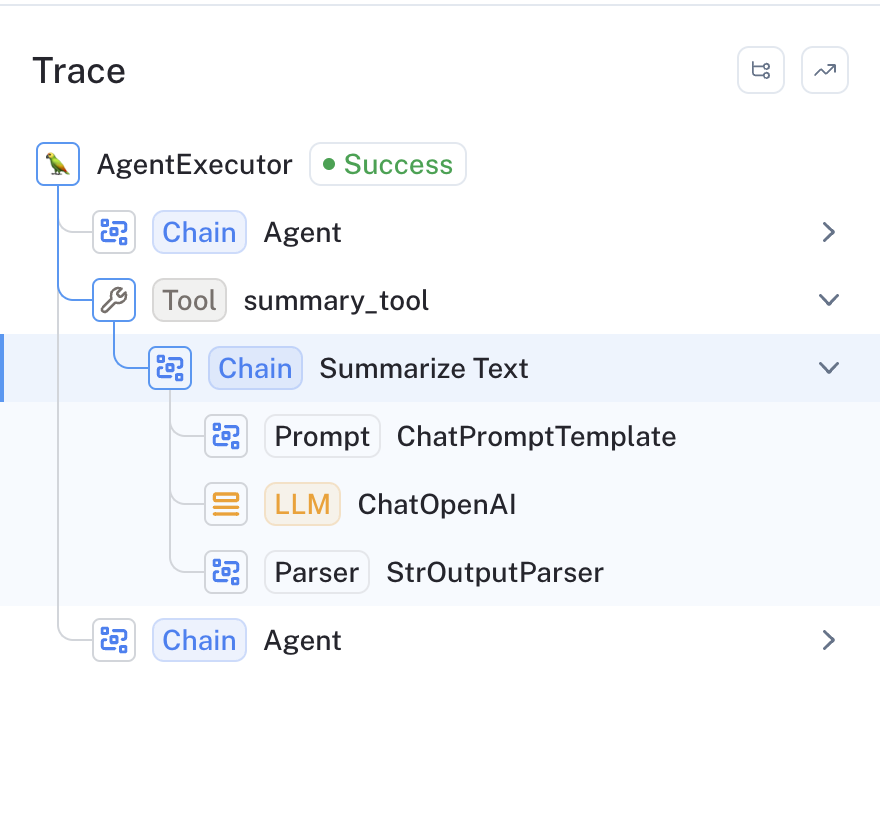Tracing Nested Calls within Tools
Tools are interfaces an agent can use to interact with any function. Often those functions include additional calls to a retriever, LLM, or other resource you'd like to trace. To ensure the nested calls are all grouped within the same trace, just use the run_manager!
The following example shows how to pass callbacks through a custom tool to a nested chain. This ensures that the chain's trace is properly included within the agent trace rather than appearing separately.
The resulting trace looks like the following:

Prerequisites
This example uses OpenAI and LangSmith. Please make sure the dependencies and API keys are configured appropriately before continuing.
%pip install -U langchain openai
import os
os.environ["LANGCHAIN_API_KEY"] = "<your api key>"
os.environ["LANGCHAIN_TRACING_V2"] = "true"
os.environ["OPENAI_API_KEY"] = "<your openai api key>"
1. Define tool
We will show how to properly structure your nested calls both when using the decorator and when subclassing the BaseTool class.
Option 1: Using the @tool decorator
The @tool decorator is the most concise way to define a LangChain tool. To propagate callbacks
through the tool function, simply include the "callbacks" option in the wrapped function. Below is an example.
import uuid
import requests
from langchain.callbacks.manager import Callbacks
from langchain.chat_models import ChatOpenAI
from langchain.prompts import ChatPromptTemplate
from langchain.schema.output_parser import StrOutputParser
from langchain.tools import tool
@tool
def summarize_tool(url: str, callbacks: Callbacks = None):
"""Summarize a website."""
text = requests.get(url).text
summary_chain = (
ChatPromptTemplate.from_template(
"Summarize the following text:\n<TEXT {uid}>\n" "{text}" "\n</TEXT {uid}>"
).partial(uid=lambda: uuid.uuid4())
| ChatOpenAI(model="gpt-3.5-turbo-16k")
| StrOutputParser()
).with_config(run_name="Summarize Text")
return summary_chain.invoke(
{"text": text},
{"callbacks": callbacks},
)
Option 2: Subclass BaseTool
If you directly subclass BaseTool, you have more control over the class behavior and state management. You can choose to propagate callbacks by accepting a "run_manager" argument in your _run method.
Below is an equivalent definition of our tool using inheritance.
import uuid
from typing import Optional
import aiohttp
import requests
from langchain.callbacks.manager import (
AsyncCallbackManagerForToolRun,
CallbackManagerForToolRun,
)
from langchain.chat_models import ChatOpenAI
from langchain.prompts import ChatPromptTemplate
from langchain.schema.output_parser import StrOutputParser
from langchain.schema.runnable import Runnable
from langchain.tools import BaseTool
from pydantic import Field
def _default_summary_chain():
"""An LLM chain that summarizes the input text"""
return (
ChatPromptTemplate.from_template(
"Summarize the following text:\n<TEXT {uid}>\n" "{text}" "\n</TEXT {uid}>"
).partial(uid=lambda: uuid.uuid4())
| ChatOpenAI(model="gpt-3.5-turbo-16k")
| StrOutputParser()
).with_config(run_name="Summarize Text")
class CustomSummarizer(BaseTool):
name = "summary_tool"
description = "summarize a website"
summary_chain: Runnable = Field(default_factory=_default_summary_chain)
def _run(
self,
url: str,
run_manager: Optional[CallbackManagerForToolRun] = None,
) -> str:
"""Use the tool."""
text = requests.get(url).text
callbacks = run_manager.get_child() if run_manager else None
return self.summary_chain.invoke(
{"text": text},
{"callbacks": callbacks},
)
async def _arun(
self,
url: str,
run_manager: Optional[AsyncCallbackManagerForToolRun] = None,
) -> str:
"""Use the tool asynchronously."""
async with aiohttp.ClientSession() as session:
async with session.get(url) as response:
text = await response.text()
callbacks = run_manager.get_child() if run_manager else None
return await self.summary_chain.ainvoke(
{"text": text},
{"callbacks": callbacks},
)
2. Define agent
We will construct a simple agent using runnables and OpenAI functions, following the Agents overview in the LangChain documentation. The specifics aren't important to this example.
from langchain.prompts import ChatPromptTemplate, MessagesPlaceholder
prompt = ChatPromptTemplate.from_messages(
[
("system", "You are very powerful assistant, but bad at summarizing thingws."),
("user", "{input}"),
MessagesPlaceholder(variable_name="agent_scratchpad"),
]
)
from langchain.chat_models import ChatOpenAI
from langchain.tools.render import format_tool_to_openai_function
# Configure the LLM with access to the appropriate function definitions
llm = ChatOpenAI(temperature=0)
tools = [summarize_tool, CustomSummarizer()]
llm_with_tools = llm.bind(functions=[format_tool_to_openai_function(t) for t in tools])
from langchain.agents import AgentExecutor
from langchain.agents.format_scratchpad import format_to_openai_functions
from langchain.agents.output_parsers import OpenAIFunctionsAgentOutputParser
agent = (
{
"input": lambda x: x["input"],
"agent_scratchpad": lambda x: format_to_openai_functions(
x["intermediate_steps"]
),
"chat_history": lambda x: x.get("chat_history") or [],
}
| prompt
| llm_with_tools
| OpenAIFunctionsAgentOutputParser()
).with_config(run_name="Agent")
agent_executor = AgentExecutor(agent=agent, tools=tools)
3. Invoke
Now its time to call the agent. All callbacks, including the LangSmith tracer, will be passed to the child runnables.
agent_executor.invoke(
{
"input": f"What's this about? https://blog.langchain.dev/langchain-expression-language/"
}
)
{'input': "What's this about? https://blog.langchain.dev/langchain-expression-language/", 'output': 'The blog post titled "LangChain Expression Language" introduces a new syntax called LangChain Expression Language (LCEL). LCEL allows users to create chains with composition and comes with a new interface that supports batch, async, and streaming. The post also mentions the creation of a "LangChain Teacher" to help users learn LCEL. Examples of how chaining can be used in language models are provided, along with the benefits of using LCEL. The post concludes by mentioning the integration of LCEL with LangSmith, another platform released by LangChain.'}
The resulting LangSmith trace should look something like the following:
Conclusion
In this example, you created a tool in two ways: using the decorator and by subclassing BaseTool. You configured the callbacks so the nested call to the "Summarize Text" chain is traced correctly.
LangSmith uses LangChain's callbacks system to trace the execution of your application. To trace nested components, the callbacks have to be passed to that component. Any time you see a trace show up on the top level when it ought to be nested, it's likely that somewhere the callbacks weren't correctly passed between components.
This is all made easy when composing functions and other calls as runnables (i.e., LangChain expression language).

